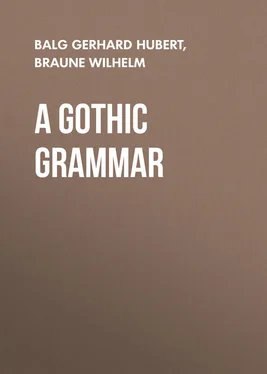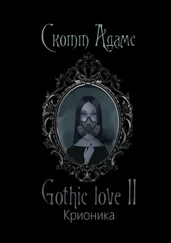Gerhard Balg - A Gothic Grammar
Здесь есть возможность читать онлайн «Gerhard Balg - A Gothic Grammar» — ознакомительный отрывок электронной книги совершенно бесплатно, а после прочтения отрывка купить полную версию. В некоторых случаях можно слушать аудио, скачать через торрент в формате fb2 и присутствует краткое содержание. Жанр: foreign_antique, foreign_prose, на английском языке. Описание произведения, (предисловие) а так же отзывы посетителей доступны на портале библиотеки ЛибКат.
- Название:A Gothic Grammar
- Автор:
- Жанр:
- Год:неизвестен
- ISBN:нет данных
- Рейтинг книги:3 / 5. Голосов: 1
-
Избранное:Добавить в избранное
- Отзывы:
-
Ваша оценка:
- 60
- 1
- 2
- 3
- 4
- 5
A Gothic Grammar: краткое содержание, описание и аннотация
Предлагаем к чтению аннотацию, описание, краткое содержание или предисловие (зависит от того, что написал сам автор книги «A Gothic Grammar»). Если вы не нашли необходимую информацию о книге — напишите в комментариях, мы постараемся отыскать её.
A Gothic Grammar — читать онлайн ознакомительный отрывок
Ниже представлен текст книги, разбитый по страницам. Система сохранения места последней прочитанной страницы, позволяет с удобством читать онлайн бесплатно книгу «A Gothic Grammar», без необходимости каждый раз заново искать на чём Вы остановились. Поставьте закладку, и сможете в любой момент перейти на страницу, на которой закончили чтение.
Интервал:
Закладка:
§ 34. V. Series: i (aí) a ê.
The vowel of the stems of this series is followd by a singl consonant other than a liquid or a nasal. E. g.
giban, gaf, gêbum, gibans, to giv ; giba, f., gift ; gabei, f., richness ; — sitan, to sit ; satjan, to set ; anda-sêts, abominabl ; — mitan, to mezure ; mitôn, to consider ; mitaþs, f., mezure ; usmêt, n., manner of life ; — ga-nisan, to be saved , recuver ; nasjan, to save ; ganists, salvation .
Note. Also saíƕan, saƕ, sêƕum, saíƕans, belongs to this class, because ƕrepresents a singl sound; § 63, n. 1.
§ 35. VI. Series: a ô.
Most of the stems of this series end in a singl consonant. E. g.
wakan, wôk, wôkum, wakans, to wake ; waknan, to awake ; wahtwô, f., wach ; wôkains, f., a waching ; — graban, to dig ; grôba, f., pit, hole ; graba, f., dich ; — fraþjan, frôþ, to understand ; fraþi, n., understanding ; frôþs, wise ; frôdei, f., understanding, wisdom ; — hafjan, hôf, to heav (tr.); -hafnan, to heav (intr.); haban, to hav, hold ; ungahôbains, f., incontinency ; — ôg, I fear ; unagands, fearless ; ôgjan, to frighten ; usagjan, to terrify ; agis, n., fear ; — sakan, to contend ; sakjô, f., strife ; sôkjan, to seek ; sôkns, f., serch, inquiry ; unand-sôks, irrefutabl .
§ 36. Series: ê ô(VII. Ablaut-Series).
A connection between êand ôoccurs in the so-calld reduplicating ablaut-verbs lêtan, laílôt, etc.; saian(= *sêan, § 22), saísô, etc.; cp. § 180et seq.
Note. This series is no longer found in the verbal inflection of the remaining Germanic languages, but its existence is proved by its occurring in word-formation; as, OHG. (â: ô) tât, f., tôn, tuon, to do ; – knâan, to know : knôt, chnuat, f., kin . – For more on this point, s. Beitr. 11, 262 et seq.
CHAP. IV. THE CONSONANTS
§ 37. The consonant-signs to be discust here both in regard to value and occurrence in the Gothic language hav alredy been enumerated in § 2 § 2. Of the 27 characters two hav only numerical values, ( § 1 , n. 2), a third, the χ, is retaind only in Greek foren words, especially in the name 'Christus', and denotes no Gothic sound. Hense there remain the following 24 characters whose fonetic values ar to be determind: (a) Consonants: p b f m w | t d þ s z n l r | k q g h ƕ j. (b) Vowels: a e i o u. (c) Difthongs: ei iu ai au. In determining the fonetic values of these characters we ar guided by the following means: (1) The Gothic alfabet is based on the Greek alfabet; hense, the pronunciation of the Greek letters to be determind for the 4th century, must also be regarded as that of the Gothic letters so long as there is no proof to the contrary. (2) The rendition of the numerous Greek foren words and proper nouns by Wulfila. (3) The transliteration of the Gothic proper nouns in Latin documents and by Latin authors of the 4th-8th centuries. (4) The testimony of the cognate Germanic languages. (5) Fonetic changes and grammatical fenomena in the Gothic language itself permit us to draw conclusions about the nature of the sounds. Note 1. Concerning the pronunciation of the Gothic letters, cp. Weingärtner, 'Die Aussprache des Gotischen zur Zeit des Ulfilas', Leipzig 1858; Fr. Dietrich, 'Ueber die Aussprache des Gotischen während der Zeit seines Bestehens', Marburg 1862; about the consonants, Paul, 'Zur Lautverschiebung', Beitr. 1, p. 147 et seq. Note 2. An old testimony for the Gothic pronunciation in the Salzburg-Vienna MS.: ubi dicit. genuit .j. ponitur ubi gabriel .g. ponunt et alia his sim̅ ubi aspiratione. ut dicitur gah libeda jah libaida diptongon ai pro e longa p ch q ponunt. – Cp. § 1 , n. 5, and, for explanation, especially Kirchhoff, p. 20 et seq.
. We divide the consonantal sounds in sonorous consonants and noizd sounds. Cp. Sievers, Grundzüge der Phonetik4, p. 70 et seq. Accordingly, the Gothic consonant-signs w, j, l, m, n, r, represent the sonorous sounds, the rest the noizd sounds.
A. SONOROUS CONSONANTS
§ 38. Germanic w and j ar the vowels u and i uzed as consonants; hense in Gothic the interchange between iand j, uand w, according to their position which determins their fonetic values as vowels or consonants. The consonantal i and u, which in other languages ar denoted by the same signs as the vocalic i and u, hav special signs in Gothic, jand w. These sounds ar also calld 'semivowels'.
§ 39. The sign of the Gothic alfabet which we represent by w, is, according to its form and alfabetic position, the Gr. υ. For this it also stands in Greek foren words, for exampl, Pawlus, Παῦλος; Daweid, Δαυίδ; aíwaggêljô, εὐαγγέλιον; paraskaíwê, παρασκευή. But the Gothic wstands not only for the Gr. υ of the combinations αυ, ευ, in which it had perhaps at that time assumed the value of a spirant, but also for simpl Greek υ, namely vocalic υ; as, Swmaíôn, Συμεών; swnagôgê, συναγωγή; martwr, μάρτυρ. But in our transcriptions of the Gothic texts the Greek vocalic υ is exprest by yinstead of w( Symaíôn, synagôgê, martyr); so, also, for practical reasons, in this book.
Note 1. A noteworthy Gothic transcription is kawtsjô(= Lt. cautio) in the document at Naples ( § 221 Конец ознакомительного фрагмента. Текст предоставлен ООО «ЛитРес». Прочитайте эту книгу целиком, купив полную легальную версию на ЛитРес. Безопасно оплатить книгу можно банковской картой Visa, MasterCard, Maestro, со счета мобильного телефона, с платежного терминала, в салоне МТС или Связной, через PayPal, WebMoney, Яндекс.Деньги, QIWI Кошелек, бонусными картами или другим удобным Вам способом.
, n. 3). Cp. Wrede, 'Ostg.', 166; Zs. fda., 36, 273.
Интервал:
Закладка:
Похожие книги на «A Gothic Grammar»
Представляем Вашему вниманию похожие книги на «A Gothic Grammar» списком для выбора. Мы отобрали схожую по названию и смыслу литературу в надежде предоставить читателям больше вариантов отыскать новые, интересные, ещё непрочитанные произведения.
Обсуждение, отзывы о книге «A Gothic Grammar» и просто собственные мнения читателей. Оставьте ваши комментарии, напишите, что Вы думаете о произведении, его смысле или главных героях. Укажите что конкретно понравилось, а что нет, и почему Вы так считаете.











